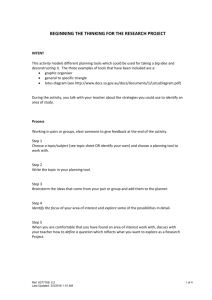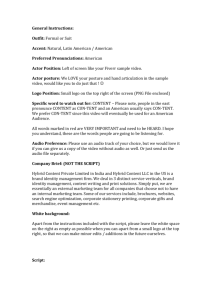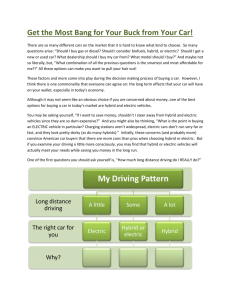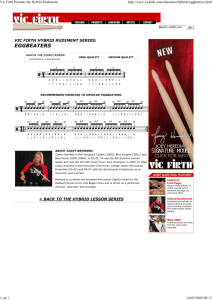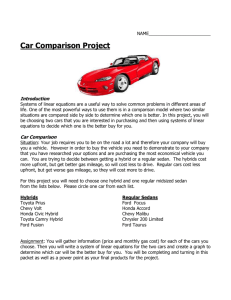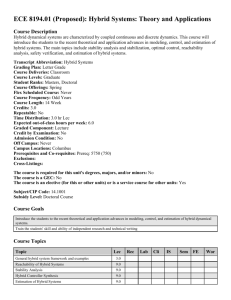File - Marisa's e
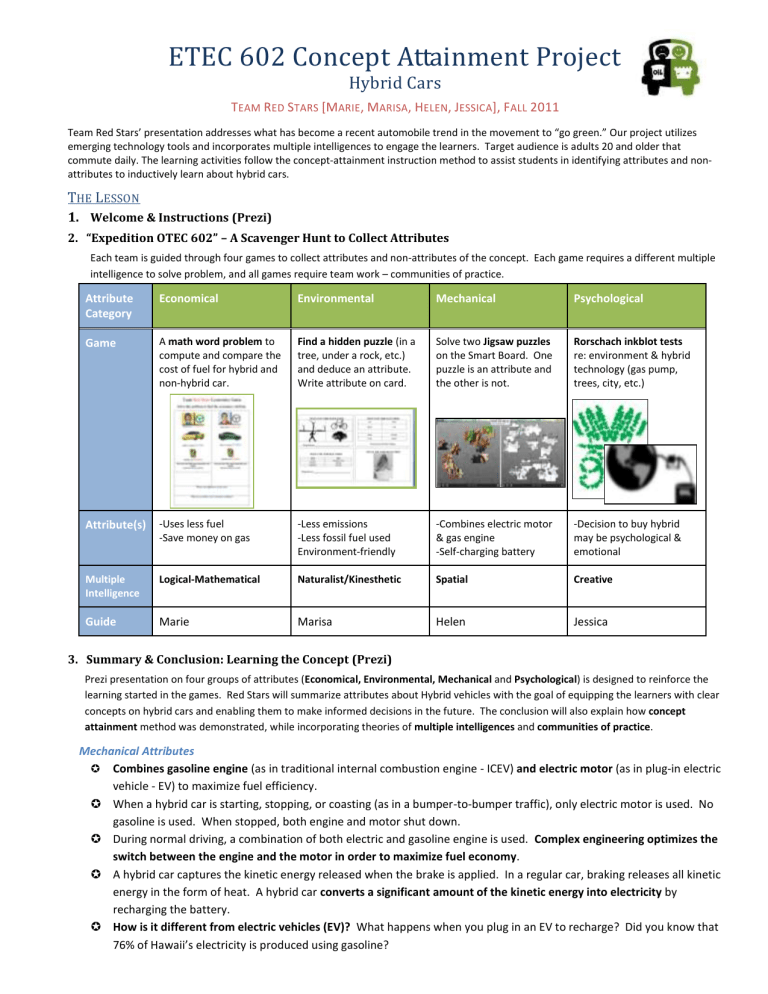
ETEC 602 Concept Attainment Project
Hybrid Cars
T EAM R ED S TARS [M ARIE , M ARISA , H ELEN , J ESSICA ], F ALL 2011
Team Red Stars’ presentation addresses what has become a recent automobile trend in the movement to “go green.” Our project utilizes emerging technology tools and incorporates multiple intelligences to engage the learners. Target audience is adults 20 and older that commute daily. The learning activities follow the concept-attainment instruction method to assist students in identifying attributes and nonattributes to inductively learn about hybrid cars.
T
HE
L
ESSON
1.
Welcome & Instructions (Prezi)
2. “Expedition OTEC 602” – A Scavenger Hunt to Collect Attributes
Each team is guided through four games to collect attributes and non-attributes of the concept. Each game requires a different multiple intelligence to solve problem, and all games require team work – communities of practice.
Attribute
Category
Economical Environmental Mechanical Psychological
Game A math word problem to compute and compare the cost of fuel for hybrid and non-hybrid car.
Find a hidden puzzle (in a tree, under a rock, etc.) and deduce an attribute.
Write attribute on card.
Solve two Jigsaw puzzles on the Smart Board. One puzzle is an attribute and the other is not.
Rorschach inkblot tests re: environment & hybrid technology (gas pump, trees, city, etc.)
Attribute(s) -Uses less fuel
-Save money on gas
-Less emissions
-Less fossil fuel used
Environment-friendly
Naturalist/Kinesthetic
-Combines electric motor
& gas engine
-Self-charging battery
Spatial
-Decision to buy hybrid may be psychological & emotional
Creative Multiple
Intelligence
Guide
Logical-Mathematical
Marie Marisa Helen Jessica
3. Summary & Conclusion: Learning the Concept (Prezi)
Prezi presentation on four groups of attributes (Economical, Environmental, Mechanical and Psychological) is designed to reinforce the learning started in the games. Red Stars will summarize attributes about Hybrid vehicles with the goal of equipping the learners with clear concepts on hybrid cars and enabling them to make informed decisions in the future. The conclusion will also explain how concept
attainment method was demonstrated, while incorporating theories of multiple intelligences and communities of practice.
Mechanical Attributes
Combines gasoline engine (as in traditional internal combustion engine - ICEV) and electric motor (as in plug-in electric vehicle - EV) to maximize fuel efficiency.
When a hybrid car is starting, stopping, or coasting (as in a bumper-to-bumper traffic), only electric motor is used. No gasoline is used. When stopped, both engine and motor shut down.
During normal driving, a combination of both electric and gasoline engine is used. Complex engineering optimizes the
switch between the engine and the motor in order to maximize fuel economy.
A hybrid car captures the kinetic energy released when the brake is applied. In a regular car, braking releases all kinetic energy in the form of heat. A hybrid car converts a significant amount of the kinetic energy into electricity by recharging the battery.
How is it different from electric vehicles (EV)? What happens when you plug in an EV to recharge? Did you know that
76% of Hawaii’s electricity is produced using gasoline?
Unlike EV, hybrid cars are not limited in range of travel because gasoline has much higher energy density than batteries: e.g. it takes about 1000 lbs of batteries to store as much energy as 1 gallon of gasoline.
Environmental Attributes
Hybrid cars may use up to 38% less gasoline and emits 42% less carbon dioxide.
A car that burns twice as much gasoline adds twice as much CO2 to the atmosphere. Hybrid cars produce less CO2, CO,
nitrogen oxides, and hydrocarbons -- all gases that may contribute to global warming.
America’s cars and trucks produce more CO2 than Europe, China, Japan, and India combined.
It is unknown how toxic the Li-ion batteries in current hybrid cars are. It is said to be less toxic than lead (most ICEV’s) or nickel metal hydride batteries (previous hybrid cars), nevertheless it must be recycled and disposed of properly.
Psychological Attributes
Hybrid cars are growing in popularity and there are more choices for a buyer:
Only 2.6% of 2010 sales were hybrid models, but the figure jumped to 4.7% in the first quarter of 2011. (Simanaitis, 2011)
Top fuel-efficient hybrid cars for 2011 are: Toyota Prius, Lexus CT200h, Honda Civic Hybrid, and Honda Insight.
J.D. Powers & Associates notes that in 2009, buyers could choose from 31 different hybrid models; this will grow to 159 by the end of 2016. (Simanaitis, 2011)
“As for the environment, there are many ways to reduce emissions - using public transport, carpooling, riding a bicycle and even walking. Even just buying a smaller, fuel efficient car makes a big difference.” (Cohen, 2011)
Economical Attributes
Higher MPG = Saves money on gas.
Hybrid technology is complex. Therefore its purchase price can be significantly higher.
The batteries that power the electric motor have a finite lifespan (5-10 years) and are expensive to replace.
There may be tax rebates or other secondary privileges such as being allowed to use carpool lanes or getting discounts on parking.
B
IBLIOGRAPHY
Webpages
Cohen, D. (2011, June 10) What is a Hybrid Vehicle? - An introduction to hybrid cars and how they are defined, with examples of different hybrid technologies. (2011, June 10). Retrieved August 28, 2011, from http://what-iswhat.com/what_is/hybrid_vehicle.html
Dunn, P. (2006, January 19). Hybrid Cars -- Pros and Cons. Retrieved August 28, 2011, from http://www.physorg.com/news10031.html
Energy Losses in a Vehicle. (n.d.). Retrieved September 27, 2011, from http://www.consumerenergycenter.org/transportation/consumer_tips/vehicle_energy_losses.html
How Hybrids Work. (n.d.). Retrieved September 26, 2011, from http://www.fueleconomy.gov/feg/hybridtech.shtml
Hybrid Battery Toxicity | Hybrid Cars. (2006, April 8). Retrieved August 28, 2011, from http://www.hybridcars.com/battery-toxicity.html
Hybrid Cars - Vehicles with multiple power sources. (n.d.). Alternative Energy. Retrieved August 28, 2011, from http://www.alternative-energy-news.info/technology/transportation/hybrid-cars/
Nice, K., & Layton, J. (n.d.). HowStuffWorks “How Hybrid Cars Work.” Retrieved August 28, 2011, from http://auto.howstuffworks.com/hybrid-car.htm
The Benefits of Hybrid Cars. (2008, May 20). Alternative Energy. Retrieved August 28, 2011, from http://www.alternative-energy-news.info/benefits-hybrid-cars/
Journals/Reports
Gleick, P. (2007). Hummer versus Prius. Oakland, CA: Pacific Institute.
Notter, D. G. (2010). Contribution of Li-Ion Batteries to the Environmental Impact of Electric Vehicles. Environ. Sci.
Technol., 6550-6556.
Simanaitis, D. (2011, September). Liquid Fuels? Electricity? Hydrogen? Road & Track, pp. 99-102.
Video
Teachers’ Domain: Cars in America: Investing in Detroit’s Future. (2008). WGBH Educational Foundation. Retrieved from http://www.teachersdomain.org/asset/frnht10_vid_cars/
T
EAM
M
EMBERS
:
Four women who grew up overseas. We love technology, teaching, learning, art, and environmental issues.
Marie grew up in Vietnam and now lives in Kaaawa on Oahu.
She is a Math & Technology teacher at La Pietra-Hawaii
School for Girls.
Marisa grew up in Japan and now lives in Honolulu. She is a digital artist and a teaching assistant. She also volunteers at Foster’s Botanical Gardens.
Jessica grew up in American
Samoa and now lives in Provo,
Utah. She is a Deal Desk
Analyst for Adobe Systems.
She has worked with
Education 2020 as a Virtual
Teacher for English Language
Arts 9-12.
Helen grew up in Korea and now lives in Hilo. She is currently an IT Specialist at
UH-Hilo.



